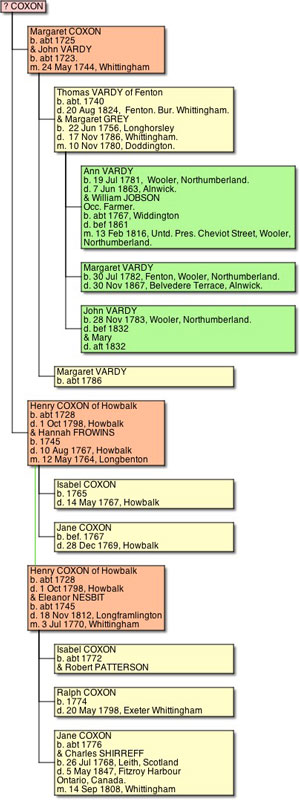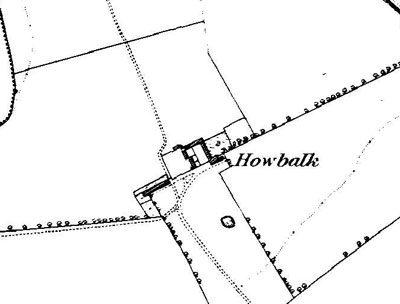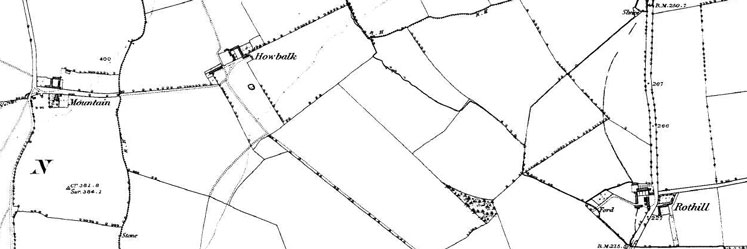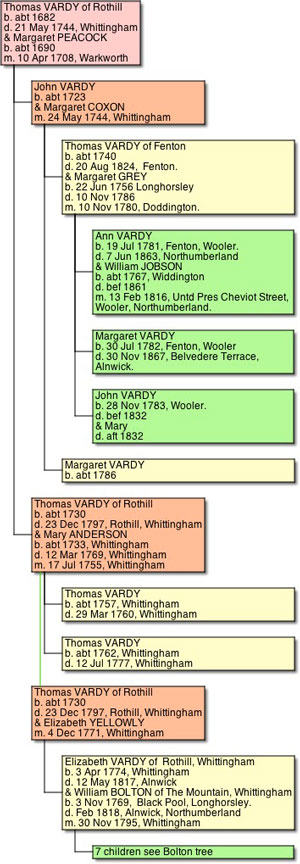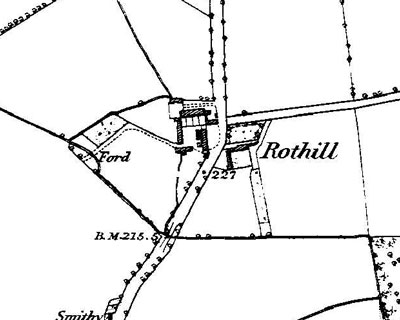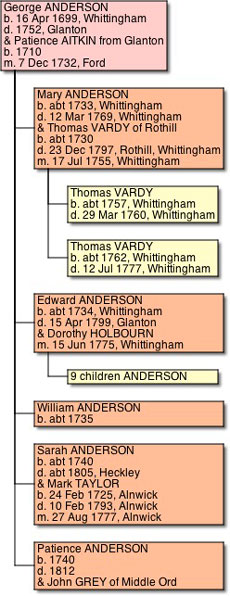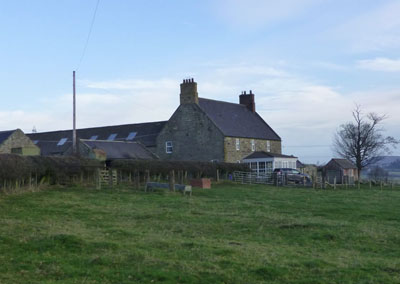
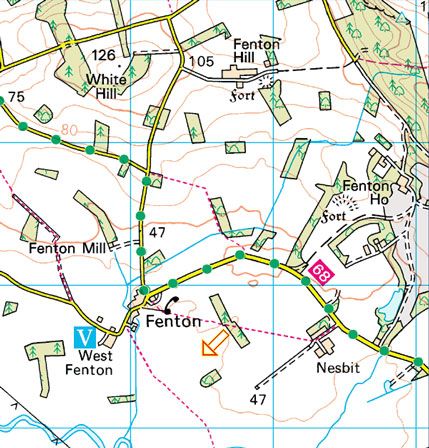
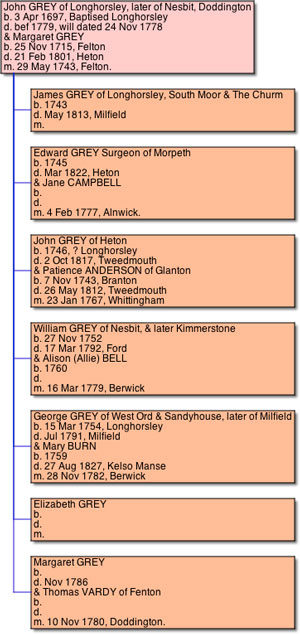

Margaret Grey
Married Thomas Vardy of Fenton on 10 November 1780 at Doddington
Buried at St. Bartholomew, Whittingham on the 22 November 1786.
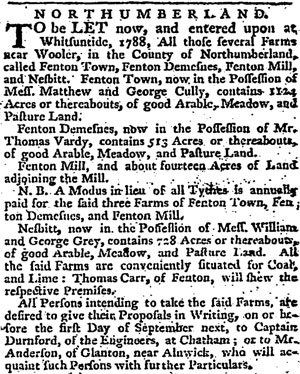
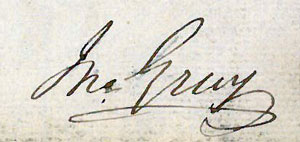
Letters of administration for Mary Vardy, wife of John, who didn't make a will. The signature of John Gray of East Lilburn can be seen left. Reproduced by permission of Durham University Library. DPR I/3/1832/A7. John Gray with an "a" farmed at East Lilburn and is described as "husbandman" according to the 1851 census. He was born in Scotland in about 1793, married to Isabella, also born in Scotland and had a daughter called Isabella. He is unlikely to be a relation.
This is the last Will and Testament of me Thomas Vardy of Fenton in the County of Northumberland Gentleman made published and declared this twenty third day of December in the year of our Lord one thousand eight Hundred and Fourteen.- I do direct that all my Just debts funeral expences and the charges of the Probate of this my Will shall in the first place be paid and satisfied. And it is my Will and I do direct that immediately after my decease an account shall be taken of all such Lease and Leases as I may be possessed of at the time of my decease and all the Farming Stock Corn Hay growing Crops Horses Cattle Implements of Husbandry Household Goods and furniture and all other my Personal Estate and Effects whatsoever and wheresoever And that a valuation of all my said Leases Farming Stock and other Effects before mentioned shall be made as soon thereafter as may be by three indifferent Persons one of whom shall be nominated and appointed by my son John Vardy one other by my two Daughters Ann and Margaret Vardy and the third by the two persons first named and the valuation of the said three Persons or any two of them shall be final and conclusive for the purposes of this my Will. And the said valuers shall make all Just and due allowances And do give and bequeath to my said son John one full halfpart of all my said Leases Farming Stock and all other my Effects before mentioned and unto my said Daughter Ann one fourth part thereof and unto my said daughter Margaret one fourth part thereof And it is my Will that if my said son John shall within twelve months after my decease pay unto my said two Daughters the value of their respective shares or give them security for the same to their respective satisfaction then I give and bequeath the whole of the said Leases Farming stock and all other my personal Estate unto my said son absolutely. I give and bequeath unto my sister Margaret one Annuity of twenty five pounds per Annum to be paid from the day of my decease by quarterly payments by my said son and Daughters in proportions to their shares of my Effects hereby bequeathed to them. And I constitute and appoint my said son sole Executor of this my will In Witness whereof I the said Testator Thomas Vardy have hereunto set my Hand and seal the day and year above written. Tho. Vardy Signed sealed published and declared by the said Testator Thomas Vardy as and for his last Will and Testament in the presence of us who in his presence at his request and in the presence of each other have hereunto subscribed our names as witnesses Rich Jobson John Grey Edward Nicholson
1830/V1/2 This Will was proved at Durham on the 8th day of June 1830 by John Vardy of Fenton in the parish of Wooler in the County of Northumberland Gentleman the Son and Sole Executor therein named To whom administration was granted He having been first duly sworn by Commission before the Reverend William Haigh, Clerk, Master of ?Arts A Commissioner in this behalf lawfully appointed faithfully to execute and perform the same as usual (Effects sworn under £6000) Burrell ?St
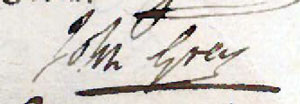
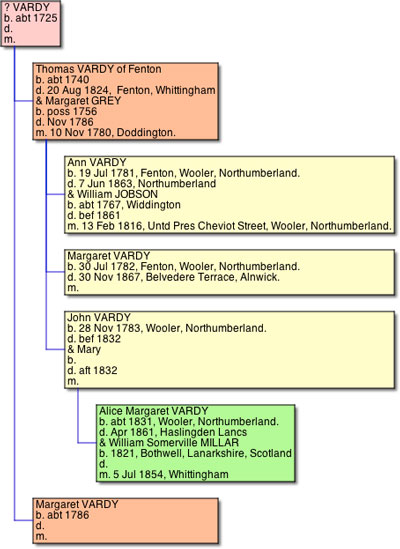
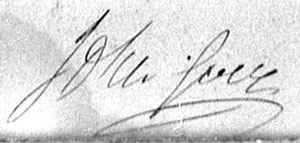
A family history of the Vardys by R. E. Vardy suggests that the Vardys of Wiltshire, Bury St Edmunds and South Africa are descended from ancestors of this Vardy family. It suggests that Thomas Vardy of Fenton was the brother of an Elizabeth Vardy of Rothill who married William Bolton of Longhorsley. This would mean Thomas of Fenton's father was Thomas Vardy of Rothill. Thomas Vardy born 1682 farmer of Rothill, Whittingham, was said to be the originator of a special breed of horses called the Vardy horse. Mentioned in this history is a letter by G. Aynsley Smith who suggests Thomas's father was John Vardy of Tesbury. As evidence he notes:
Burials 13 Mar 1690 Mary wife of. John Vardy
13 February 1695 George son of John Vardy
12 Nov 1719 Richard Vardy Miller Tesbury"
However the author comments that Thomas may be John’s grandson or son of George or Richard. "Tesbury" seems unlikely. The Vardys are numerous in parish registers around Alnwick and it seems more likely to be Lesbury.
"Thomas Vardy of Fenton born 1783 admitted " tenant in “Halmote court rolls" at age of 12. This was a form of feudal land tenure, which carried right to be admitted by Lord of Manor as one of registered tenants on his estate. It was hereditary; R.E. Vardy suggests that possibly he derived his claim from his mother Ann daughter of Thomas Clarke gentleman of Durham Castle. The Earls of Durham had seats in Fenton & Wooler.
R. E. Vardy's family tree is inserted left but has not been verified and it is thought to be inaccurate.
“The Vardys and Associated families” by R.E.Vardy In family History Tracts Vol. 50 & 52 at Society of Genealogists.
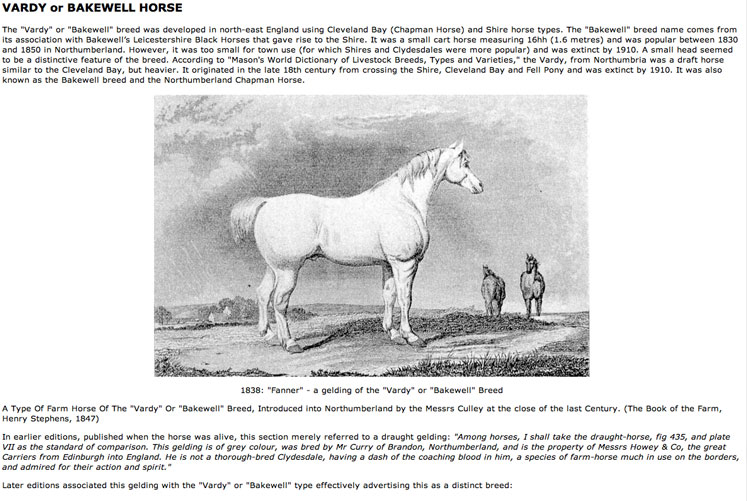
LIVE STOCK NEGLECTED BREEDS OF HORSES. SURVIVAL OF THE CLEVELAND BAY. Upon the subject of horse breeds in Great Britain that have been allowed to run out, a writer in the "Mark-Dane Express" offers the opinion that it is difficult to estimate the loss the country has, sustained by the neglect of breeds of horses which at one time had become established in various parts of the kingdom. These breeds were established primarily because of the need of some such horse. For example, the Clydesdale, or Shire, was utterly unfitted for the work of the Devon shire pack horse or the Chapman horse, as the Cleveland Bay was originally called. On the rough roads, in many places, wheeled traffic was impossible, and the pack horse a necessity. When the utility of the older breeds was shown in other ways they were preserved and bred on more or less scientific lines till the types became thoroughly established. In these breeds there was a lot of horses admirably adapted for draught as well as for lighter work, and as a foundation for strong saddle horses they were invaluable. The breeds to which allusion may be more particularly directed, are the Cleveland Bay, the Devonshire pack horse, the Yorkshire coach horse, the old Holderness cart horse and the Northumberland Vardy horse.
The five breeds enumerated were good, and doing good, but for quite a perfunctory reason they became unfashionable. Then came the spirit of progress and so-called improvement, and whilst one set of breeders endeavored to improve them in in another direction. Then those who bred one direction, another set was equally busy for utility only - that is, for the purposes of the farm. Seeing that certain 'breeds had, so to speak, lost their vogue, got rid of the old -stock as quickly as possible and crossed with the heavy breeds till they had lost the former types.
There are, however, still the Cleveland Bays and Yorkshire coach horses left, and here and there may be a Devonshire pack horse. But the Vardy and the Holderness cart horse have gone. These breeds are lost, and of the former very little is known by the present generation, and even in his native Northumberland he is now scarcely known by name. The books have nothing to say of his history, even that most accurate of historians, the late Cadwallader J. Bates, never once mentions him in his history of Northumberland. What was the original home of the breed-whether it was localised in one corner of the county or spread over the whole of it, I have been unable to discover. That it was rapidly approaching extinction in the latter part of the eighteenth century may well be believed.
The Vardy was a short-legged, active horse of the draught type. He was not a heavy horse, as heavy horses are known nowadays. His bone was very clean, flat and flinty in texture, very like the bone of the Cleveland Bay, and he had no feather in the modern sense of the word. He was under rather than over 16 hands, had fair action and shoulders good enough to carry a saddle. Indeed, when he was "trimmed up," he made a very good weight carrying hack, as he possessed good pace as well as stamina. A horse possessing such characteristics as the Vardy was by the very nature of things in a dangerous position He could be got at from both sides. He could be crossed with the thoroughbred or the hackney to "improve" him in one direction: and with the heavier Clydesdale or Shire to improve him in the other. This is no doubt what took place, and in the process the original breed was lost.
Sir Jacob Wilson remembered a few individuals of the breed that were, he said, fine horses for work. He looked upon their loss as serious, as they had hardy constitutions, had plenty of bone and substance, could carry weight and could get over the ground. There is a theory that they were descended from the horses which carried the Northumbrian men at arms on their raids. Sir Jacob Wilson said he had seen a horse that at any rate had a lot of Vardy blood in him. This was a horse named Silvertail, who travelled the Cleveland district in the sixties. He was bought at Newcastle fair without a pedigree, and was a good looking grey horse with the silver main and tail from which he got his name. He was about 16 hands high, was a very fine mover, had good clean bone, and was a remarkably high couraged horse. The owner had a couple of horses by him, and two better or harder horses he does not think he ever saw. They would have cut a poor figure in a show ring amongst the modern draught breeds, but when they were at their best, they would have made the best of these cut a sorry figure beside them when it came to work. As they could very cleverly manage 25 cwt. loads, or if it came to a pinch even a ton and a half, their powers of draught were sufficient for all practical purposes. In a plough they could work any of the heavier horses to a standstill. The younger horse was as good a harness horse as ever was yoked to a dog cart. This was found out by accident. One morning the owner had a train to catch, and the harness horse came out lame. The grey horse was handy, and put in the dog cart. He covered the four and a half miles to the station within twenty minutes without being touched with the whip.
Digitized newspapers on line. Leader (Melbourne, Vic. : 1862 - 1918) ( Saturday 25 April 1914 http://trove.nla.gov.au/ndp/del/article/89312832
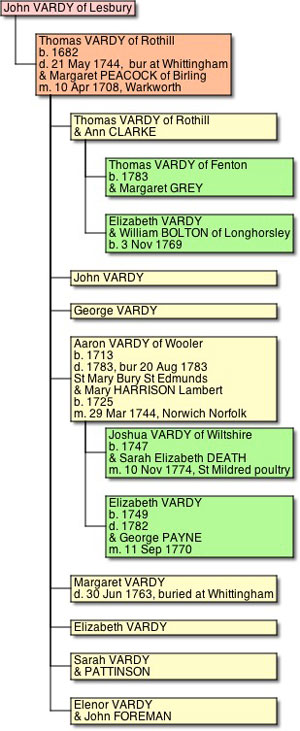
"Durham Marriage Bonds.
Dec 4 1771, Thomas Vardy, Whittingham, 21 wdr
Yellowly, Elz, Lowick, 21
Grey, John, Longhorsley."
